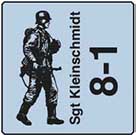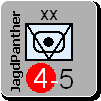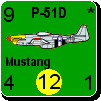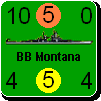amwild
Posts: 105
Joined: 2/9/2004
Status: offline

|
quote:
ORIGINAL: Shannon V. OKeets
The basic idea of FOW as envisioned (double entendre) for MWIF is that you will see all the units on the map and know their basic unit type. You won't know their numbers though. For the air units, that means you won't know for certain which hexes each air unit can reach (bomber attacks, fighter cover), beyond the obvious nearby hexes. For the land units, that means the units in the rear areas will be hidden. For example, if the USSR retreats units that had not been engaged in combat the previous turn (say during the winter months), the German player will have to first move units adjacent to the retreated units to determine their strength. The mechanism I am thinking of using here is to have all the unit specifics be removed from enemy units (they all become blank) and then redraw them based on whether they are hidden or known. Reinforcements that pop up in rear areas will have their details hidden.
The FOW will be minor for heavily engaged forces:
1 - all adjacent units will be known
2 - all units that fought in the previous turn (not impulse) will be known
3 - all units within the extended 'seeing range' of air units will be known
If a front is static (e.g., China, North Africa, Great Britain), then knowledge concerning the enemy will be less. Which seems right.
Anyway, we are just kicking this around and I am open to everyone's thoughts, ideas, comments, and suggestions about FOW.
There is nothing in WIF FE even close, so we are not restricted by history (double entendre) in what we decide for MWIF. It should add to the enjoyment of playing the game - that's the overriding criterion for how to define it. Oh, and it will be optional of course.
Then there is Fred's idea of using Intelligence Points for revealing hidden units.
A friend of mine said that he implemented Fog of War in one of his house rules by not allowing opponents to examine the contents of a stack of units until an attack was declared. Players could see the height of an enemy stack, and could see the top unit, but were not allowed to examine the contents of a stack unless they decided to attack it. Merely moving next to a stack of enemy units wouldn't tell the player what was in the stack. Thus, being able to place a particular unit at the top of the stack was important - the player may wish to emphasise strength by placing a strong unit at the top, or may wish to seem weaker by displaying a weak unit.
The only problem came when tall stacks of units fell over... Not a problem that a computer would have.
I suppose that intelligence points could be used to take a peek at some hidden characteristic of a stack, such as showing the strongest or weakest non-visible unit, or revealing the stack's total attack or defense rating, or if intelligence points are rare enough, spending a point is required to allow the entire contents of a stack to be examined.
|
 Printable Version
Printable Version
















 .
.

 . I am sure that there are people who will want FoW, so it should be included.
. I am sure that there are people who will want FoW, so it should be included.
 New Messages
New Messages No New Messages
No New Messages Hot Topic w/ New Messages
Hot Topic w/ New Messages Hot Topic w/o New Messages
Hot Topic w/o New Messages Locked w/ New Messages
Locked w/ New Messages Locked w/o New Messages
Locked w/o New Messages Post New Thread
Post New Thread